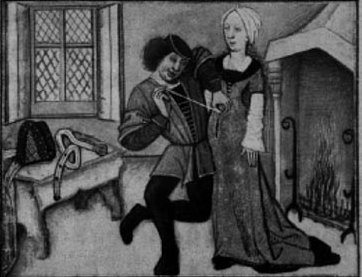Sewing tips – Machine vs Hand Sewing
 If you want to have your kit as authentic as possible, then you need to hand sew all your kit! Sewing machines were not available during the medieval period; people slaved away for hours and hours making their clothes by hand, as they had no alternatives. Today we have the sewing machine and it is up to you if you use it.
If you want to have your kit as authentic as possible, then you need to hand sew all your kit! Sewing machines were not available during the medieval period; people slaved away for hours and hours making their clothes by hand, as they had no alternatives. Today we have the sewing machine and it is up to you if you use it.Everyone who knows me knows I hate sewing machines and I hand stitch my clothes. That said, I do not expect that of everyone. Do what you feel is right and what is easiest for you. If you have a sewing machine, continue to use it – if you don't then try hand sewing. The construction guide for the kit that follows can be used for hand or machine sewing. If you choose to machine sew then you still need to hand sew all the visible parts of your garment – neck, cuff and hem lines and any other appropriate/visible parts. If you're not sure on your hand sewing ability then why not start with some simple patterns for shirts, shifts or bags, which you can sew in camp and ask advice upon.
Whichever method you decide on, remember that you need to iron your garment at several stages during its construction to get it to hang right or look more professional.
If you are used to modern clothes there are some differences that you should be aware of:
i. Everything in the 15th century was hand sewn and while it's fine for you to do the main seams and such on a machine, please do all the stitching that will be visible once the garment is finished by hand. This generally means hand finishing and hemming. Also if you make anything unlined be careful, zigzagged or over locked seams are rather obvious.
ii. All shaping was done by making garments out of several panels and using gussets in places like under arms. Darts don't seem to have existed and the use of them changes the look so please don't use them.
iii. Linings were generally used unless you have a specific reason not to use them. However, there are times when it is not wanted. For instance, if you are using a heavily fulled (thickly woven) cloth so you can dagg it (patterned edges), you don't need a lining. In these cases, you can finish off the edges either by hemming or with small facings, silk is often used because of it's strength and it's only a tiny bit. Linings should either be linen or wool.
